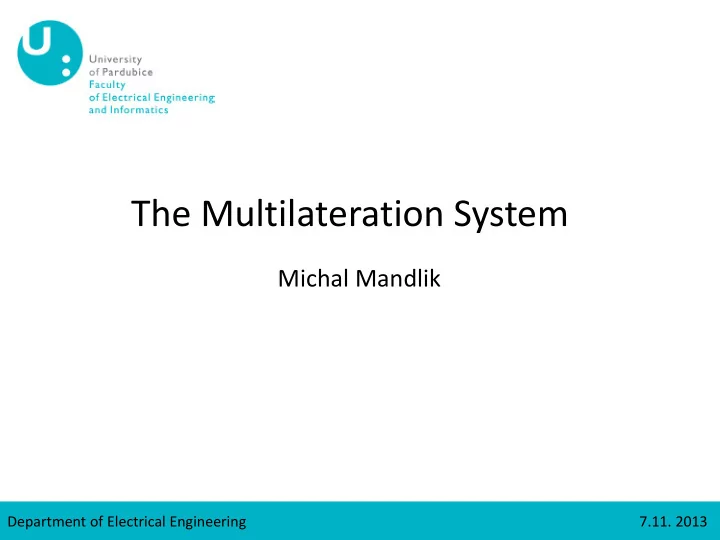

The Multilateration System Michal Mandlik Department of Electrical Engineering 7.11. 2013
INTRODUCTION • The multilateration system description • The properties of the multilateration system • The time delay estimation • The position estimation • The error analysis Department of Electrical Engineering 7.11. 2013 1
THE MULTILATERATION SYSTEM DESCRIPTION Multilateration system gets the aircraft position through three or more • distributed receivers. A multilateration system is called Time Difference of Arrival system (TDOA) as well. These receivers are connected with a central unit via the communication link. The task of the estimation of the aircraft position can be split into the • two independent parts. The first one is the time delay estimation and the second one is the position estimation. Both part are discused in the following sections. A modeling TDOA system for a short base passive radar system based on • Automatic Dependent Surveillance-broadcast messages. Thus, a well- known parameters is estimated the maximum position error. Department of Electrical Engineering 7.11. 2013 2
THE MULTILATERATION SYSTEM DESCRIPTION For known receivers positions [ x j , y j , z j ] and transfer delays τ j including the individual signal delays in the particular paths) for j =(1, 2, 3, 4) we get a set of nonlinear measurement equations for the unknown aircraft position [ x 0 , y 0 , z 0 ]. Principle of MLAT − ( ) R R − = + τ − τ + δ j i t t t j i j i ji c Where: t j is the time of arrival, of the signal to the j- th receiver, R j is a transmitter to the j -th receiver distance, c is the velocity of light, δ t ji is a summary TDOA measurement error. Department of Electrical Engineering 7.11. 2013 3
THE TIME DELAY ESTIMATION For time delay estimation is necessary to get the most precision • estimator. This goal is solved by the best unbiased estimator of the time difference of arrivals of two unknown signals. It is based on a Cross-Correlation Function (CCF) of those received signals. Unfortunately the signals contains the additive noise. Noise has the Gaussian distribution and the noise is uncorrelated • with the received signals. Curve fitting provides better estimation of CCF. • The receive signal is shown at the figure. • Department of Electrical Engineering 7.11. 2013 4
THE POSITION ESTIMATION The resulting set of linear equations leads to the following estimation of • the variance matrix S of the target position deviation vector δ r 0 using the Least Squares Method (LSM) S = ( D H D ) -1 D H . W . D .( D H D ) -1 Where D is a differential measurement matrix and W is a variance matrix of measurement errors as follows: S = var( δ r 0 ) δ r 0 = [δ x 0 , δ y 0 , δ z 0 , ] W = var( ε ); ε = [δ t 1 , δ t 2 , δ t 3 , δ t 4 ] ; Where δ r 0 is a vector of target coordinates deviations, ε is a vector consisting of measurement errors δ t j of the times of arrivals t j or their disturbances with correlations, described by the variance matrix W Department of Electrical Engineering 7.11. 2013 5
THE POSITION ERROR ANALYSIS The position error is highly influenced by • the time error estimation and the receivers‘ array geometry. The shape of the array influences the error distribution for a particular direction. The receivers’ positions errors are not • correlated with other error. The figure shows the error analysis for the • star array geometry. The position error is computed using these • equations. ε = δ di a g ( D R . ) r [ ] = = δ δ δ δ δ ; δ δ ,δ ,δ x y z R r r r r r j j j j 1 2 3 4 Department of Electrical Engineering 7.11. 2013 6
ACKNOWLEDGEMENT & CONTACT Michal Mandlik michal.mandlik@student.upce.cz Department of Electrical Engineering Faculty of Electrical Engineering and Informatics University of Pardubice Czech Republic http://www.upce.cz/en/fei/ke.html The research was supported by the Internal Grant Agency of University of Pardubice SGS FEI 09/2013. Department of Electrical Engineering 7.11. 2013 7
Recommend
More recommend